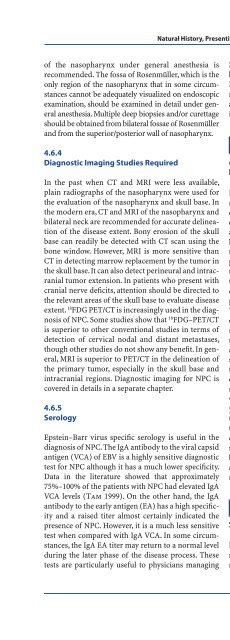Familial Nasopharyngeal Carcinoma 6
Familial Nasopharyngeal Carcinoma 6
Familial Nasopharyngeal Carcinoma 6
- No tags were found...
You also want an ePaper? Increase the reach of your titles
YUMPU automatically turns print PDFs into web optimized ePapers that Google loves.
Natural History, Presenting Symptoms, and Diagnosis of <strong>Nasopharyngeal</strong> <strong>Carcinoma</strong> 49of the nasopharynx under general anesthesia isrecommended. The fossa of Rosenmüller, which is theonly region of the nasopharynx that in some circumstancescannot be adequately visualized on endoscopicexamination, should be examined in detail under generalanesthesia. Multiple deep biopsies and/or curettageshould be obtained from bilateral fossae of Rosenmüllerand from the superior/posterior wall of nasopharynx.4.6.4Diagnostic Imaging Studies RequiredIn the past when CT and MRI were less available,plain radiographs of the nasopharynx were used forthe evaluation of the nasopharynx and skull base. Inthe modern era, CT and MRI of the nasopharynx andbilateral neck are recommended for accurate delineationof the disease extent. Bony erosion of the skullbase can readily be detected with CT scan using thebone window. However, MRI is more sensitive thanCT in detecting marrow replacement by the tumor inthe skull base. It can also detect perineural and intracranialtumor extension. In patients who present withcranial nerve deficits, attention should be directed tothe relevant areas of the skull base to evaluate diseaseextent. 18 FDG PET/CT is increasingly used in the diagnosisof NPC. Some studies show that 18 FDG–PET/CTis superior to other conventional studies in terms ofdetection of cervical nodal and distant metastases,though other studies do not show any benefit. In general,MRI is superior to PET/CT in the delineation ofthe primary tumor, especially in the skull base andintracranial regions. Diagnostic imaging for NPC iscovered in details in a separate chapter.4.6.5SerologyEpstein–Barr virus specific serology is useful in thediagnosis of NPC. The IgA antibody to the viral capsidantigen (VCA) of EBV is a highly sensitive diagnostictest for NPC although it has a much lower specificity.Data in the literature showed that approximately75%–100% of the patients with NPC had elevated IgAVCA levels (Tam 1999). On the other hand, the IgAantibody to the early antigen (EA) has a high specificityand a raised titer almost certainly indicated thepresence of NPC. However, it is a much less sensitivetest when compared with IgA VCA. In some circumstances,the IgA EA titer may return to a normal levelduring the later phase of the disease process. Thesetests are particularly useful to physicians managingNPC in endemic area because raised titers of the antibodieswill raise the suspicion of the presence of NPC.In patients with an apparently normal clinical examinationbut with raised titers of IgA antibodies to VCAand EA, further detailed examination of nasopharynxis warranted to avoid a missed diagnosis of NPC.4.7Algorithm of a StandardizedDiagnostic ProcedureIn patients suspected to have NPC, a thorough examinationof the posterior nasal space, along with acomplete physical examination including a neckexamination, should be the initial step. In patients withan obvious NPC, endoscopically guided biopsy underlocal anesthesia should be performed to obtain tissuefor definitive diagnosis. If the biopsy does not yield apathologic diagnosis, a repeat biopsy under local anesthesiaor deep biopsies/curettage under general anesthesiawould be necessary. In patients with suspiciousclinical features such as unilateral serous otitis media,persistently elevated IgA to EBV, impairment of V andVI nerve function, or suspicious skull base lesionon diagnostic imaging, but with a normal lookingnasopharynx, endoscopically guided biopsies of thenasopharynx including bilateral fossae of Rosenmüllerand the superior/posterior wall under local anesthesiashould be performed. If the first biopsy does not yieldthe diagnosis, a repeat biopsy under local anesthesia ordeep biopsies/curettage under general anesthesia isrecommended. In patients who have suspected NPCwith cervical adenopathy but with a normal nasopharynx,pathologic diagnosis can be obtained from one ofthe enlarged cervical nodes using fine needle aspiration.If squamous cell carcinoma or undifferentiatedcarcinoma is confirmed, endoscopically guided biopsiesof the nasopharynx under local anesthesia or deepbiopsies/curettage of the nasopharynx under generalanesthesia should be performed. Figure 4.4 summarizesthe diagnostic algorithm.4.8Summary<strong>Nasopharyngeal</strong> carcinoma (NPC) is uncommon inmost parts of the world and often presents a diagnosticchallenge to physicians who have limited











